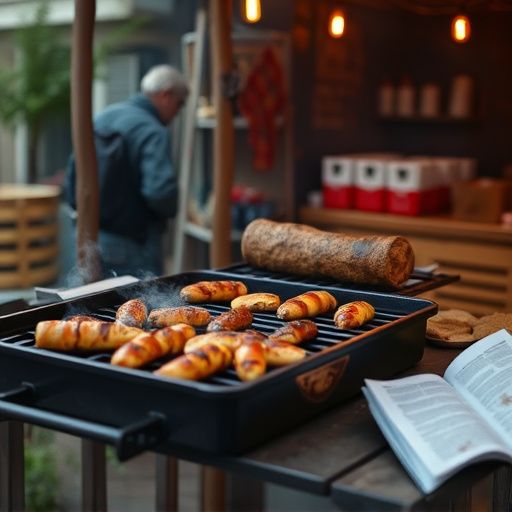To get perfect BBQ pork ribs, choose "baby back" or "spare rib" cuts with a thick fat cap for juiciness. Dry brine ribs for 12-24 hours to enhance flavor and moisture. Craft a personalized seasoning rub with sweet, smoky, and savory elements. Cook at 225-275°F (107-135°C) using indirect heat methods. Slow cook gently to break down collagen for remarkable tenderness. Add sauces or glazes for enhanced flavor and visual appeal. Rest ribs for 10-15 minutes post-cooking, slice, and savor the rich flavors.
“Unleash your inner grill master with our comprehensive guide to crafting the perfect BBQ pork ribs recipe. Discover the secrets to achieving juicy, tender ribs that melt in your mouth. From selecting the ideal cut for optimal tenderness to mastering dry brining and seasoning techniques, we cover it all. Learn how temperature control and slow cooking times contribute to fall-off-the-bone ribs. Explore delicious rub recipes and finish with saucy glazes for an unforgettable dining experience.”
- Choosing the Right Cut for Tender Ribs
- Dry Brining for Maximum Juiciness
- The Art of Seasoning: Rub Recipes
- Mastering the Grill: Temperature Control
- Slow Cooking for Fall-Off-the-Bone Ribs
- Sauces and Glazes: Adding Flavor
- Resting and Serving: Locking in Juices
Choosing the Right Cut for Tender Ribs
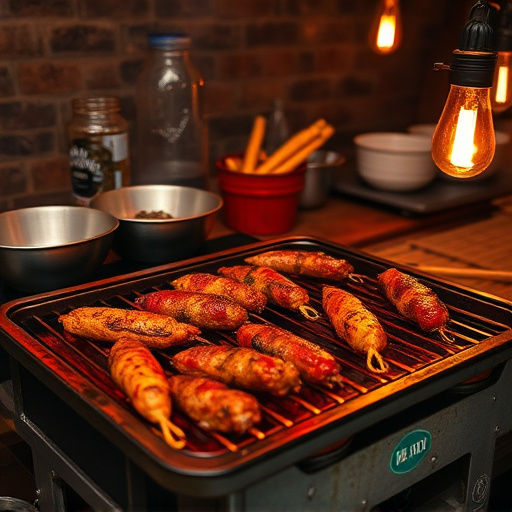
When it comes to achieving juicy and tender BBQ pork ribs, selecting the right cut is half the battle won. Look for ribs with a good balance of meat and bone, often referred to as “baby back” or “spare rib” cuts. These cuts have a higher meat-to-bone ratio compared to other varieties, ensuring that your ribs remain succulent during the slow cooking process.
The key is to choose ribs with a thick layer of fat cap over the meat. This natural covering acts as a barrier against direct heat, keeping the ribs moist and tender. A well-marbled rib will result in a richer flavor profile, making it the perfect choice for any BBQ pork ribs recipe aimed at achieving that signature juicy texture.
Dry Brining for Maximum Juiciness

Dry brining is a simple yet effective technique to transform your BBQ pork ribs recipe into an absolutely juicy and tender delight. By curing the ribs with salt, sugar, and various spices for several hours or even overnight, you draw out moisture from the meat, replacing it with the dry brine. This process not only enhances flavor but also ensures that the ribs remain moist and tender during the grilling process.
The key to successful dry brining is patience. Allow the ribs to sit in the refrigerator, covered loosely with plastic wrap, for 12 to 24 hours. After this time, rinse off the brine and pat the ribs dry before grilling. This step will help achieve that perfect balance of flavors, making your BBQ pork ribs recipe a true crowd-pleaser.
The Art of Seasoning: Rub Recipes
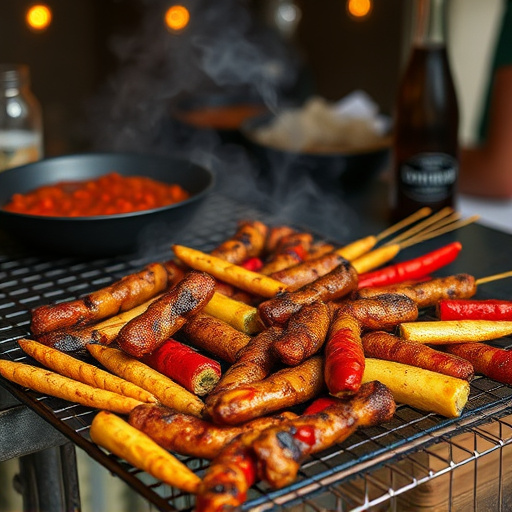
The seasoning rub is a key element in achieving juicy and flavorful BBQ pork ribs. It’s essentially a dry mix of spices that gets rubbed onto the meat to infuse it with a burst of aroma and taste. The right combination of spices can transform ordinary ribs into a mouthwatering masterpiece.
When crafting a rub recipe, consider a balance of sweet, smoky, and savory flavors. Brown sugar or molasses add sweetness, while paprika, chili powder, and cayenne pepper bring heat and smokiness. Garlic and onions in either powdered or fresh form lend a pungent kick, and herbs like thyme and rosemary contribute a subtle earthy note. Experimenting with different ratios of these ingredients will help you create a rub tailored to your taste preferences, ensuring that every grill session yields perfectly seasoned, tender, and juicy BBQ pork ribs.
Mastering the Grill: Temperature Control

Mastering temperature control is key to achieving juicy and tender BBQ pork ribs in your recipe. Grilling involves high heat searing to lock in flavors, followed by slow, indirect cooking to break down tough collagen. The ideal rib temperature hovers around 225-275°F (107-135°C). This range allows for steady, even cooking without burning the exterior or overcooking the interior. Invest in a good meat thermometer to monitor the ribs’ internal temperature throughout the process.
For optimal results, preheat your grill to the desired temperature before placing the ribs on it. Indirect heat cooking means positioning the ribs away from the direct flame, either by using a smoker box or creating a zone of lower heat with charcoal and wood chunks. This allows for slow, moist cooking that transforms tough cuts of meat into tender, succulent BBQ pork ribs.
Slow Cooking for Fall-Off-the-Bone Ribs
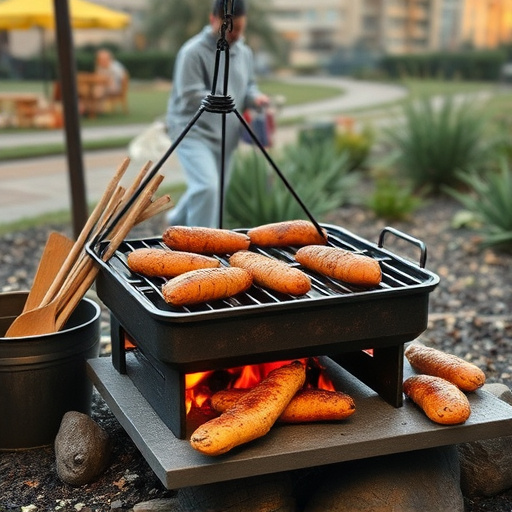
For incredibly juicy and tender BBQ pork ribs, consider slow cooking as a game-changer. This method allows the meat to cook gently over low heat, transforming tough rib cuts into melt-in-your-mouth treats. Start by rubbing your ribs with a dry rub of your choice; this step enhances flavor and helps seal in moisture during the lengthy cooking process. Place them in a slow cooker or oven-safe container, adding a splash of BBQ sauce or broth to prevent drying out.
Slow cooking is an art that requires patience but delivers exceptional results. The low and steady temperature breaks down collagen, transforming it into gelatin, which makes the ribs incredibly tender. This method also ensures even cooking, resulting in ribs that are fall-off-the-bone perfect.
Sauces and Glazes: Adding Flavor
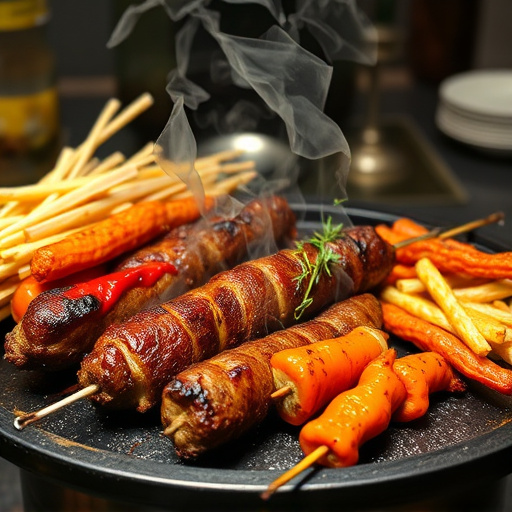
Adding sauces and glazes to your BBQ pork ribs recipe is a game-changer, enhancing both flavor and appearance. These condiments not only make your ribs more delectable but also help in sealing in the juices, ensuring they remain tender and juicy throughout. When choosing a sauce, consider balancing sweetness with smokiness for that perfect blend of flavors. A classic BBQ glaze, for instance, combines brown sugar, ketchup, and vinegar, offering a rich, tangy taste that complements the charred exterior and tender meat.
Experimenting with different sauces allows you to tailor your ribs to your preference. For a more adventurous approach, try adding a touch of heat with chili sauce or even incorporate herbs like rosemary or thyme for an aromatic twist. Remember, the key is to apply these glazes strategically during the grilling process, allowing them to caramelize and create a crispy, glossy finish on your ribs while locking in that mouthwatering juiciness.
Resting and Serving: Locking in Juices
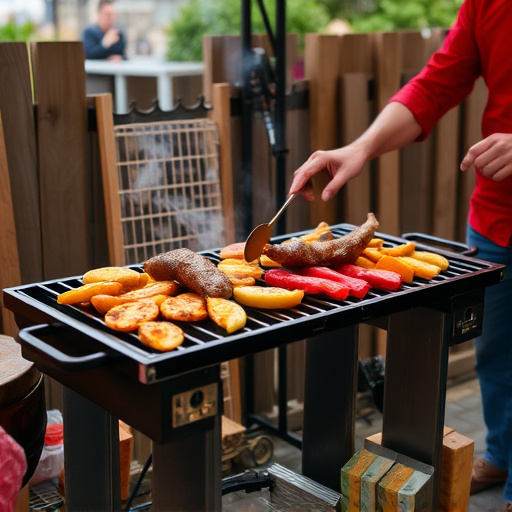
After grilling your BBQ pork ribs to perfection, allowing them to rest is a crucial step that ensures they remain juicy and tender. During this resting period, the juices redistribute themselves throughout the meat, locking in that delicious flavor and keeping your ribs moist. Aim for at least 10-15 minutes of rest after removing them from the heat source. This simple process can significantly enhance the overall dining experience.
When serving your mouthwatering ribs, consider sliced or chopped options to encourage slow eating, which allows more time for the juices to be savored. This technique not only ensures a satisfying taste but also prevents any dryness that might occur if they are served immediately after grilling. Resting and properly serving your BBQ pork ribs recipe is an art that will undoubtedly impress your guests and elevate your outdoor cooking game.
